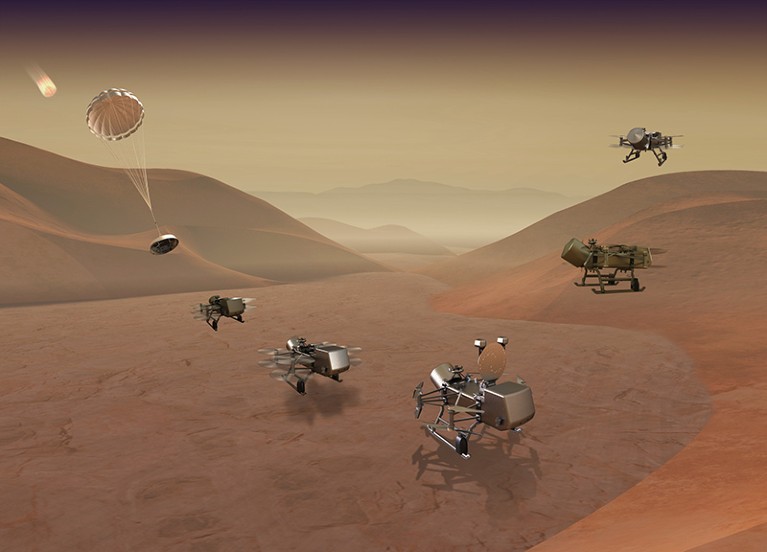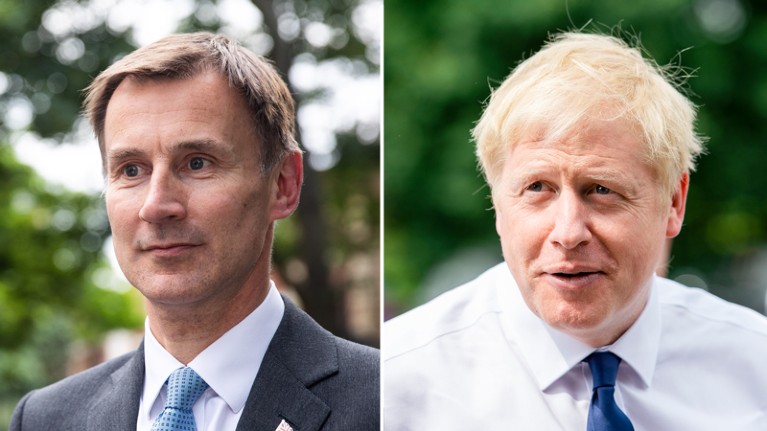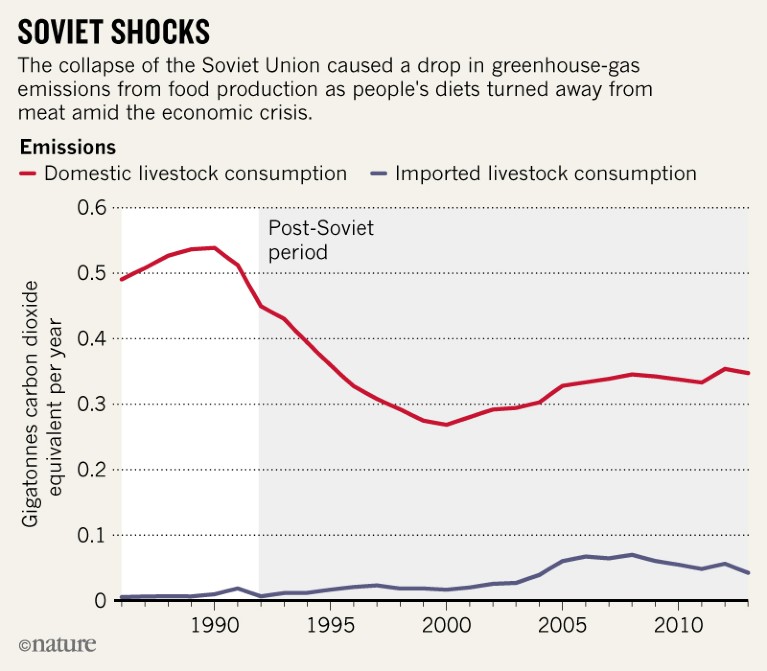SPACE
NASA drone to soar across Titan NASA will send a dual-quadcopter drone to hop across the surface of Titan, Saturn’s largest moon, the agency announced on 27 June. Named Dragonfly, the US$850-million mission will launch in 2026 and arrive at Titan in mid-2034. The nuclear-powered drone (pictured, artist’s impression) could traverse hundreds of kilometres during its two-year mission. It will study the hydrocarbon-rich clouds in Titan’s atmosphere and the methane and ethane lakes on the moon’s surface. Some of the lakes grow and shrink as seasons change on Titan; this process might leave behind residue rich with organic compounds similar to those that might have existed on Earth before life arose. “Titan has all of the key ingredients needed for life,” says Lori Glaze, head of NASA’s planetary-sciences division.

Credit: Johns Hopkins APL
Great ball of fire Astronomers watched a small asteroid approach and then disintegrate in Earth’s atmosphere on 22 June. It is only the fourth time an incoming asteroid has been detected and tracked all the way to impact. The first such instance occurred in October 2008 over northern Sudan. The University of Hawaii’s ATLAS telescope on Mauna Loa discovered the 5-metre-wide asteroid, named 2019 MO, on 22 June, when it was about 500,000 kilometres from Earth. The object entered the atmosphere and burnt up over Puerto Rico, where a lightning detector on a US weather satellite recorded the flash of light from the fireball.
EVENTS
Privacy lawsuit A lawsuit filed against Google, the University of Chicago Medical Center in Illinois and the University of Chicago has accused the hospital of sharing medical records with the technology company without sufficiently anonymizing them or obtaining proper consent. The complaint, a potential class-action suit filed in a US district court on 26 June, argues that although names were stripped from the records, they still contained dates of admission and release from the medical centre, as well as physicians’ notes. The lawsuit alleges that this information, combined with location and other data that Google routinely collects on its users, could allow patients to be identified, violating their privacy. “The claims in this lawsuit are without merit,” said the University of Chicago Medical Center in a statement. Both Google and the hospital said that they have complied with the laws and regulations pertaining to patient privacy.
Funding crackdown Taiwan seems to be tightening its grip on researchers who get funding from mainland China, out of concern that it might be losing talent and intellectual property to the mainland. According to Taiwan’s Central News Agency, the island’s government is investigating seven researchers for allegedly joining the Thousand Talents Plan — a prestigious programme to encourage academics to work in mainland China — without the necessary permissions. Although the Council for Mainland Affairs, which manages Taiwan’s relationship with the mainland, refused to comment on this directly to Nature, it did say that it was increasingly monitoring the mainland’s attempts to attract Taiwan’s high-tech talent and industrial technology. It also said that Taiwan’s cabinet, called the Executive Yuan, has directed its Ministry of Education and Ministry of Science and Technology to send letters to universities and research and education institutions to remind their staff that they need permission to participate in the Thousand Talents Plan, or to receive funding from the mainland China government.
Stigma fears The Massachusetts Institute of Technology (MIT) in Cambridge has warned against creating a “toxic atmosphere” for researchers of Chinese descent amid mounting claims that a US government crackdown on foreign influence is targeting such scholars. In an open letter published on 25 June, MIT president Rafael Reif said that researchers of Chinese origin “now feel unfairly scrutinized, stigmatized and on edge — because of their Chinese ethnicity alone” in their dealings with the government. Research institutes are under growing pressure from government agencies, including the National Institutes of Health (NIH), to confront the potential for foreign states to steal intellectual property. The NIH disputes that racial bias has contributed to its investigations, and emphasizes the need to address problematic behaviours by grantees.
POLICY
Call to back science A group of science societies, universities and charitable research funders has called on the next prime minister of the United Kingdom to commit to maintaining the country’s position as a world leader in science. The call, published in a 27 June letter by the London-based science-advocacy group the Campaign for Science and Engineering, urges the two leadership candidates — Jeremy Hunt (pictured, left)and Boris Johnson (pictured, right) of the governing Conservative Party — to put research and innovation at the heart of their plans for the country. It asks them to pledge the necessary financial support for research and development and to set out a long-term plan for science. The signatories include Britain’s Royal Society, research funder Cancer Research UK and Universities UK, which represents higher-education institutes. UK Prime Minister Theresa May stepped down on 7 June after almost three years in the post. The next leader will be decided in a vote by Conservative Party members, and is expected to be announced in the week of 22 July.

Credit: (Left) Luke Dray/Getty; (Right) Peter Powell/Getty
PUBLISHING
Approved journals India’s higher-education regulator has culled hundreds of journals from a government ‘white list’ of titles, after finding that many are “predatory or dubious”. The Consortium for Academic and Research Ethics (CARE), which was set up by the University Grants Commission (UGC) in November, screened more than 3,800 mostly Indian journals using an algorithm to verify that they are legitimate, and other measures to appraise their quality. Previously, universities could recommend journals for inclusion, and the UGC provided little scrutiny. The updated list now contains just 815 mostly Indian journals spanning the sciences and humanities. It also includes more than 50,000 journals indexed in the international journal databases Scopus and Web of Science. CARE does not assess these. Universities use the white list to evaluate researchers for promotion and hiring.
UNIVERSITIES
European alliances The European Commission last week announced 17 university alliances that will create joint higher-education programmes and boost mobility for scholars and students. The alliances comprise between 4 and 11 institutions, and some focus on particular fields of study — including ocean research, social sciences and global health — whereas others are multidisciplinary. The European Universities Initiative, launched in 2017, has been promoted by French President Emmanuel Macron. Each alliance will receive €5 million (US$5.7 million) over the next 3 years to implement its plans. The initiative attracted applications from 54 consortia that included more than 300 higher-education institutions across Europe. The winners, selected by independent reviewers, include 114 institutions across 24 countries. France and Germany were most successful, with 16 and 15 universities involved, respectively. Three universities from the United Kingdom, which plans to leave the European Union before the end of the year, are involved.
TREND WATCH
The Soviet Union’s collapse in 1991 led to a huge drop in greenhouse-gas emissions because many people stopped eating meat as the prices of consumer products soared and the rouble weakened. Meat from domestic livestock was a food staple during communist rule: in 1990, Soviet citizens each consumed an average 32 kilograms of beef a year, four times more than the global average at the time. But meat demand and livestock production fell drastically after the bloc’s collapse, and swathes of cropland were abandoned. The changes to the agriculture system resulted in a net reduction of 7.6 billion tonnes of greenhouse-gas emissions (carbon dioxide equivalent) from 1992 to 2011, researchers found from an analysis of livestock consumption and international-trade data. The figure is equivalent to one-quarter of CO2 emissions from Amazon deforestation over the same period, and it takes into account emissions from domestic and imported meat, as well as carbon locked in soils and plants on abandoned Soviet cropland. The authors suggest that meat-related emissions are rising again: Russia has become a major beef importer.

Source: F. Schierhorn et al. Environ. Res. Lett. 14, 065009 (2019)



